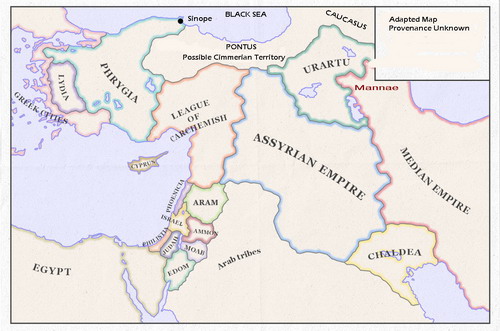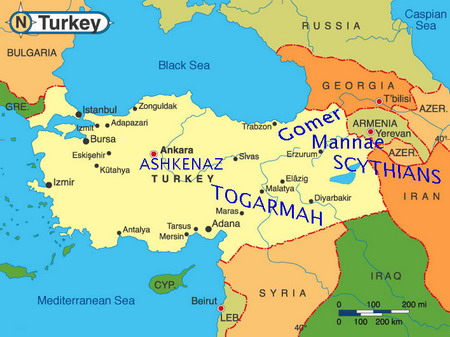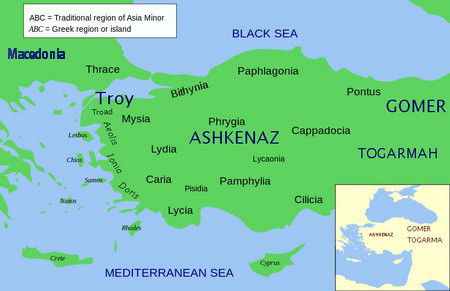Descendants of Ashkenaz son of Gomer (26 January, 2015, 6 Shevet, 5775)
Contined from Gomer the Gentile

Contents:
4. Identifications of Ashkenaz
5.Ethnic Germans, Ashkenazi Jews, and Yiddish

4. Identifications of Ashkenaz
Ashkenaz is often identified with the Scyths. One of the names given the Scythians in Assyrian scripts was Ashguz or Ashkuz which could easily have been pronounced similarly to Ashkenaz.
Ashkenaz was attributed "Asia" (Genesis Rabah 37) meaning an area by Sardes in Lydia (Western Turkey by Phrygia), as well possibly as a region in Cilicia (Southeast Turkey), and to part of Afghanistan. The name Ashkenaz was also given (Targum Jehonathan on Ezekiel 27;23) to Haydayb (i.e. Adiabene) in Northern Syria which in the Talmud (Yebamot 17) is equated with Habor whereto part of the Exiled Israelites were taken (2-Kings 17;6). The Targum Jerushalemi identifies Ashkenaz with the BARBARI which is an ethnic connotation for the so called "Germanic" peoples who attacked and invaded the Roman Empire ca.200-500 c.e. Elsewhere both the Barbari and the Germans are identified with Edom. In ancient times the term BARBAR was used synonymously with the term for Hebrew. Adiabene, which one source ascribed to Ashkenaz, is also attributed (Genesis Rabah 37) to Riphah brother of Ashkenaz.
Ashkenaz
http://en.wikipedia.org/wiki/Ashkenaz
From Wikipedia, the free encyclopedia
Ashkenaz is often identified with the Scythians and Sarmatians, due in part to the use of the name "Ashkuz" (Saka) for the Scythians in Assyrian Akkadian inscriptions. It may also refer to the Phrygians, who according to Homer's Iliad settled around Lake Ascania. The Assyrian Gimirri and Hebrew Gomer have likewise been associated with the Cimmerians.
In rabbinic literature, the kingdom of Ashkenaz was first associated with the Scythian region, then later with the Slavic territories,[1]
(Kraus. S, 1932, Hashemot 'ashkenaz usefarad, Tarbiz 3:423-435)
and, from the 11th century onwards, with northern Europe and Germany (Kriwaczek, Paul (2005). Yiddish Civilization: The Rise and Fall of a Forgotten Nation. London: Weidenfeld & Nicolson. ISBN 0-297-82941-6. , Chapter 3, footnote 9).
The region of Ashkenaz was centred on the Rhineland and the Palatinate (notably Worms and Speyer), in what is now the westernmost part of Germany. Its geographic extent did not coincide with the German Christian principalities of the time, and it included northern France.
How the name of Ashkenaz came to be associated in the rabbinic literature with the Rhineland is a subject of speculation. [Kriwaczek, Paul (2005). ibid]
In rabbinic literature from the 11th century, Ashkenaz was considered the ruler of a kingdom in the North and of the Northern and Germanic people.
In 1498, a monk named Annio da Viterbo published fragments known as "Pseudo-Berossus", now considered a forgery, claiming that Babylonian records had shown that Noah had more than the three sons listed in the Bible. Specifically, Tuiscon or Tuisto is given as the fourth son of Noah, who had been the first ruler of Scythia and Germany following the dispersion of peoples, with him being succeeded by his son Mannus as the second king.
Later historians (e.g. Johannes Aventinus and Johann Hubner) managed to furnish numerous further details, including the assertion by James Anderson in the early 18th century that this Tuiscon was in fact none other than the biblical Ashkenaz, son of Gomer.[5] James Anderson's 1732 tome Royal genealogies reports a significant number of antiquarian or mythographic traditions regarding Askenaz as the first king of ancient Germany, for example the following entry:
Askenaz, or Askanes, called by Aventinus Tuisco the Giant, and by others Tuisto or Tuizo (whom Aventinus makes the 4th son of Noah, and that he was born after the flood, but without authority) was sent by Noah into Europe, after the flood 131 years, with 20 Captains, and made a settlement near the Tanais [estuary of the Don River, Black Sea], on the West coast of the Euxin [Black] sea (by some called Asken from him) and there founded the kingdom of the Germans and the Sarmatians...
In the vocables of Saxony and Hessia, there are some villages of the name Askenaz, and from him the Jews call the Germans Askenaz, but in the Saxonic and Italian, they are called Tuiscones, from Tuisco his other name. ...
The 20 captains or dukes that came with Askenaz are: Sarmata, from whom Sarmatia; Dacus or Danus - Dania or Denmark; Geta from whom the Getae; Gotha from whom the Goths; Tibiscus, people on the river Tibiscus; Mocia - Mysia; Phrygus or Brigus - Phrygia; Thynus - Bithynia; Dalmata - Dalmatia; Jader - Jadera Colonia; Albanus from whom Albania; Zavus - the river Save; Pannus -Pannonia; Salon - the town Sale, Azalus - the Azali; Hister - Istria; Adulas, Dietas, Ibalus - people that of old dwelt between the rivers Oenus and Rhenus; Epirus, from whom Epirus.
Askenaz had a brother called Scytha (say the Germans) the father of the Scythians, for which the Germans have of old been called Scythians too (very justly, for they came mostly from old Scythia) and Germany had several ancient names; for that part next to the Euxin was called Scythia, and the country of the Getes, but the parts east of the Vistule or Weyssel were called Sarmatia Europaea, and westward it was called Gallia, Celtica, Allemania, Francia and Teutonia; for old Germany comprehended the greater part of Europe; and those called Gauls were all old Germans; who by ancient authors were called Celts, Gauls and Galatians, which is confirmed by the historians Strabo and Aventinus, and by Alstedius in his Chronology...
==============================
===============================
5. Ethnic Germans, Ashkenazi Jews, and Yiddish
Ashkenazi Jews have little in common with the real Ashkenazim of Germany other than the name.
Ashkenaz was the name given in Jewish writings to Northern France and to the Rhineland of Germany and and then later to all Germany. The Jews were driven out of Germany and moved to the east bringing their customs and language with them. They were known as Ashkenazim after the places they had come from. Since they were culturally superior local Jews copied their ways. So all East European Jews as well as those of Germany and France became known as Ashkenazim.
At least that is what historians usually assume.
Another possibility exists which is that the Jews of eastern Europe settled in townships which at that time spoke German.
In the period 200 BCE to ca. 450 CE surges of peoples speaking Germanic languages moved westward. They were followed by others speaking Slavic tongues and possessing a Slavic culture. In simplified terms from ca. 850 CE right up to 1850 the process westward was reversed and Germans began moving back towards the east. Areas close to Germany such as Prussia eventually became German in language and culture. Further east, in places such as Poland and Rumania, townships were set up by German settlers. The local non-Germanic rulers often considered themselves a different race from those they ruled over. They encouraged Germanic settlement. Natives who settled in these towns accepted German culture and eventually were considered ethnic Germans. (Occasionally it worked in the opposite direction. Numerous Germans from Saxony settled in Hungary, adopted the Magyar tongue and henceforth were regarded as native Hungarians.) Jews too were part of this process. Jews settled in the towns. Like everyone else they adopted the language already prevailing in the townships. Even Jews in the countryside regarded themselves as associated with the town communities. In the earlier stages the prevailing dialect in the townships was a type of southern German. This had a seminal effect in the formation of the Yiddish Language.
Ashkenazi Jews
From Wikipedia, the free encyclopedia
http://en.wikipedia.org/wiki/Ashkenazi_Jews
Extracts:
Ashkenazi Jews, also known as Ashkenazic Jews or simply Ashkenazim... are a Jewish ethnic division that coalesced in the Holy Roman Empire around the end of the 1st millennium.[13] The traditional language of Ashkenazi Jews consisted of various dialects of Yiddish.
They established communities throughout Central and Eastern Europe, which had been their primary region of concentration and residence until recent times, evolving their own distinctive characteristics and diasporic identities.[14] Once emancipated, weaving Jewish creativity into the texture of European life (Hannah Arendt),[15] the Ashkenazi made a 'quite disproportionate and remarkable contribution to humanity' (Eric Hobsbawm[16]), and to European culture in all fields of endeavour: philosophy, scholarship, literature, art, music and science.[17][18] The genocidal impact of the Holocaust, the mass murder of approximately 6 million Jews during World War II devastated the Ashkenazi and their Yiddish culture, affecting almost every Jewish family.[19][20]
It is estimated that in the 11th century Ashkenazi Jews composed only three percent of the world's Jewish population, while at their peak in 1931 they accounted for 92 percent of the world's Jews. Immediately prior to the Holocaust, the number of Jews in the world stood at approximately 16.7 million.[21] Statistical figures vary for the contemporary demography of Ashkenazi Jews, oscillating between 10 million[1] and 11.2 million.[2] Sergio Della Pergola in a rough calculation of Sephardic and Mizrahi Jews, implies that Ashkenazi make up less than 74% of Jews worldwide.[22] Other estimates place Ashkenazi Jews as making up about 75% of Jews worldwide.[23]
See Also:
Togarmah. Descendants of Gomer
